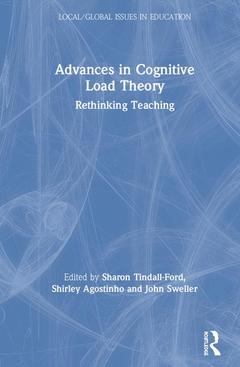Advances in Cognitive Load Theory Rethinking Teaching Local/Global Issues in Education Series
Coordonnateurs : Tindall-Ford Sharon, Agostinho Shirley, Sweller John

Cognitive load theory uses our knowledge of how people learn, think and solve problems to design instruction. In turn, instructional design is the central activity of classroom teachers, of curriculum designers, and of publishers of textbooks and educational materials, including digital information. Characteristically, the theory is used to generate hypotheses that are tested using randomized controlled trials. Cognitive load theory rests on a base of hundreds of randomized controlled trials testing many thousands of primary and secondary school children as well as adults.
That research has been conducted by many research groups from around the world and has resulted in a wide range of novel instructional procedures that have been tested for effectiveness. Advances in Cognitive Load Theory, in describing current research, continues in this tradition. Exploring a wide range of instructional issues dealt with by the theory, it covers all general curriculum areas critical to educational and training institutions and outlines recent extensions to other psycho-educational constructs including motivation and engagement.
With contributions from the leading figures from around the world, this book provides a one-stop-shop for the latest in cognitive load theory research and guidelines for how the findings can be applied in practice.
List of Figures and Tables
List of Contributors
Chapter 1. Introduction John Sweller
Part 1: General Theoretical Advances
Chapter 2. Load Reduction Instruction (LRI): Sequencing Explicit Instruction and Guided Discovery to Enhance Students’ Motivation, Engagement, Learning, And Achievement Andrew J. Martin and Paul Evans
Chapter 3. How Cognitive Load Theory Can Be Applied to Collaborative Learning: Collaborative Cognitive Load Theory Jimmy Zambrano R., Paul A. Kirschner And Femke Kirschner
Chapter 4. Cognitive Load Theory and Working Memory Models: Comings and Goings Sébastien Puma and André Tricot
Part 2: Specific Research Advances and Research Procedures
Chapter 5. Using Arrow-Lines to Integrate Pictorial and Textual Information in Electronic Slideshow Assisted Lecturing Tzu-Chien Liu, Yi -Chun Lin and Yu-Chen Kuo
Chapter 6. How to Measure Effects of Self-Regulated Learning with Checklists on the Acquisition of Task Selection Skills Jimmie Leppink, Fred Paas, Tamara Van Gog and Jeroen J. G. Van Merriënboer
Chapter 7. The Effects of Transient Information and Element Interactivity on Learning from Instructional Animations Mona Wong, Juan C. Castro-Alonso, Paul Ayres and Fred Paas
Chapter 8. Visuospatial Tests and Multimedia Learning: The Importance of Employing Relevant Instruments Juan C. Castro-Alonso, Paul Ayres, Mona Wong and Fred Paas
Part 3: Human Movement, Pointing, Tracing and Gesturing
Chapter 9.Embodying Learning through Physical Activity and Gestures in Preschool Children Myrto Mavilidi, Kim Ouwehand, Anthony D. Okely, Paul Chandler and Fred Paas
Chapter 10.Learning Human Physiology by Pointing and Tracing: A Cognitive Load Approach Paul Ginns and Amy Kydd
Chapter 11.Gesture-Based Learning with ICT: Recent Developments, Opportunities and Considerations Stoo Sepp, Shirley Agostinho, Sharon Tindall-Ford and Fred Paas
Chapter 12.Embodied Cognition? Effects of Pointing and Tracing Gestures an Learning Performance, Eye Movement and Cognitive Load Babette Park, Andreas Korbach, Paul Ginns and Roland Brünken
Part 4: New Effects and New Conditions Required for Old Effects
Chapter 13. Self-Management of Cognitive Load: Potential and Challenges Faisal Mirza, Shirley Agostinho, Sharon Tindall-Ford, Fred Paas and Paul Chandler
Chapter 14.Effects of Informed Use: A Proposed Extension of the Self-Management Effect Alexander Eitel, Lisa Bender, and Alexander Renkl
Chapter 15. Factors That Impact on The Effectiveness of Instructional Animations Paul Ayres, Juan C. Castro-Alonso, Mona Wong, Nadine Marcus and Fred Paas
Chapter 16. The Effects of Self-Regulation Training on Self-Regulated Learning Competencies and Cognitive Load: Does the Socioeconomic Status Matter? Ferdinand Stebner, Corinna Schuster, Theresa Dicke, Yves Karlen, Joachim Wirth And Detlev Leutner
Chapter 17. What Should Students Do First When Learning How to Solve A Physics Problem: Try To Solve It Themselves or Study A Worked Example? Slava Kalyuga And Chih-Yi Hsu
Chapter 18. The Centrality of Element Interactivity to Cognitive Load Theory Wayne Leahy and John Sweller
Chapter 19. Conclusions John Sweller, Sharon Tindall-Ford & Shirley Agostinho
Sharon Tindall-Ford is an Associate Professor of Educational Psychology at the University of Wollongong. Her research interests in the area of cognition and instruction have focused on a number of cognitive load effects including the modality effect, worked example effect, imagination effect and self management of cognitive load. She is particularly interested in how these effects are implemented within primary and secondary classrooms.
Shirley Agostinho is an Associate Professor of Educational Technology at the University of Wollongong. Her research focuses on how teachers design and how learners support their own learning using digital technologies. Her interest in cognitive load theory is concerned with how learners can apply cognitive load theory principles to support their learning.
John Sweller is an Emeritus Professor of Educational Psychology at the University of New South Wales. His research is associated with cognitive load theory. The theory is a contributor to research on issues associated with human cognition, its links to evolution by natural selection, and the consequences for instructional design.
Date de parution : 06-2019
15.6x23.4 cm
Date de parution : 06-2019
15.6x23.4 cm
Disponible chez l'éditeur (délai d'approvisionnement : 14 jours).
Prix indicatif 46,39 €
Ajouter au panierThèmes d’Advances in Cognitive Load Theory :
Mots-clés :
Evolutionary Educational Psychology; Cognitive Load Theory; Cognitive Load Theory Perspective; Instructional Design; SRL Competency; Quantitative Data; Cognitive Load Perspective; Correlational Methods; Extraneous Cognitive Load; Cognitive Load Measurement; Cognitive Load; Modality Effect; Intrinsic Cognitive Load; Working Memory; Van Der Vleuten; Embodied Cognition; High Intrinsic Cognitive Load; Load Reduction Instruction; Cognitive Load Effect; secondary school children; High Element Interactivity; classroom teachers; Human Cognitive Architecture; Instructional Animations; Split Attention Effect; Element Interactivity; Transient Information; Spatial Judgment Task; SRL Training; Seductive Details; Dual Complex Tasks; TBRS Model; Working Memory Models; Visuospatial Processing



